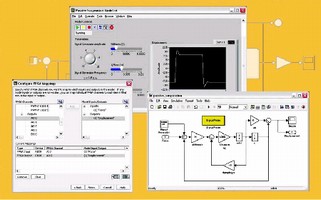Integrate LabVIEW with MATLAB and Simulink

Integrating LabVIEW with MATLAB and Simulink opens up powerful possibilities for engineers and scientists, allowing seamless exchange of data, control algorithms, and simulations between these two versatile platforms. LabVIEW, developed by National Instruments, is renowned for its graphical programming environment used extensively in data acquisition, instrument control, and industrial automation. MATLAB, developed by MathWorks, is a high-level programming language and interactive environment used for numerical computation, data analysis, and algorithm development. Simulink is an extension of MATLAB that provides a graphical programming environment for modeling, simulating, and analyzing multidomain dynamic systems.
Why Integrate LabVIEW with MATLAB and Simulink?
Integrating LabVIEW with MATLAB and Simulink offers several benefits:
- Complementary Capabilities: Leverage LabVIEW’s real-time data acquisition and control capabilities with MATLAB’s advanced numerical computation and algorithm development.
- Simulation and Modeling: Combine LabVIEW’s hardware interfacing capabilities with Simulink’s graphical simulation and modeling environment for system-level design and validation.
- Data Analysis: Use MATLAB for in-depth data analysis, visualization, and processing of data acquired through LabVIEW applications.
- Algorithm Development: Develop and implement complex control algorithms in Simulink and integrate them with LabVIEW for real-time execution and testing.
Integrating LabVIEW with MATLAB
1. MATLAB Integration Options
Explore various methods to integrate LabVIEW with MATLAB:
- MATLAB Script Nodes: Use LabVIEW’s MATLAB Script nodes to execute MATLAB scripts within LabVIEW VIs (Virtual Instruments).
- MATLAB Data Acquisition Toolbox: Utilize MATLAB’s Data Acquisition Toolbox for acquiring data from LabVIEW-supported hardware directly into MATLAB for analysis.
2. Passing Data Between LabVIEW and MATLAB
Facilitate data exchange between LabVIEW and MATLAB:
- File I/O: Save data acquired in LabVIEW to files (e.g., .csv, .mat) and load them into MATLAB for analysis.
- TCP/IP Communication: Implement TCP/IP communication between LabVIEW and MATLAB using TCP/IP functions to send data packets.
3. Using Shared Libraries
Create shared libraries in LabVIEW and call them from MATLAB:
- LabVIEW Shared Libraries: Build LabVIEW VIs into shared libraries (.dll or .so) that MATLAB can call using MATLAB’s External Interfaces feature.
4. Automating MATLAB from LabVIEW
Control MATLAB from LabVIEW using ActiveX or MATLAB Automation Server:
- ActiveX Automation: Use LabVIEW’s ActiveX Automation capabilities to control MATLAB sessions and execute MATLAB commands programmatically.
- MATLAB Automation Server: Interact with MATLAB via its Automation Server, enabling seamless integration for data processing and algorithm execution.
Integrating LabVIEW with Simulink
1. Using Simulink Desktop Real-Time
Utilize Simulink Desktop Real-Time for integrating with LabVIEW:
- Simulation Interfaces: Interface LabVIEW with Simulink models using Simulink Desktop Real-Time for hardware-in-the-loop (HIL) simulations.
- Real-Time Simulation: Run LabVIEW-generated code or hardware interfaces within Simulink for real-time simulation and testing.
2. Model Reference and External Mode
Integrate LabVIEW with Simulink using Model Reference and External Mode:
- Model Reference: Create Simulink model references that interface with LabVIEW VIs for exchanging data and control signals.
- External Mode: Use Simulink’s External Mode feature to interactively tune parameters and monitor simulation results in real-time using LabVIEW.
3. Using MATLAB Function Block in Simulink
Incorporate MATLAB algorithms into Simulink models using MATLAB Function blocks:
- MATLAB Function Block: Implement MATLAB algorithms directly in Simulink models using MATLAB Function blocks, leveraging MATLAB’s computational capabilities.
Applications and Benefits
Explore practical applications and benefits of integrating LabVIEW with MATLAB and Simulink:
- Control Systems: Design and simulate control algorithms in Simulink, then implement and test them in real-time using LabVIEW-controlled hardware.
- Data Acquisition and Analysis: Acquire data in LabVIEW from sensors or instruments, then perform detailed analysis and visualization in MATLAB.
- System-Level Design: Model complex dynamic systems in Simulink, validate designs with LabVIEW-acquired data, and refine algorithms in MATLAB.
Best Practices and Considerations
Adopt best practices for successful integration:
- Compatibility: Ensure compatibility between LabVIEW, MATLAB, and Simulink versions for seamless integration and functionality.
- Data Format: Standardize data formats (e.g., numeric arrays, structures) for consistent data exchange between LabVIEW and MATLAB/Simulink.
- Error Handling: Implement robust error handling mechanisms to manage exceptions and ensure system reliability during integration.
Advanced Techniques and Integration
Explore advanced techniques for specific integration scenarios:
- Real-Time Data Streaming: Implement real-time data streaming between LabVIEW and Simulink/MATLAB for continuous data processing and analysis.
- Custom Interfaces: Develop custom interfaces or protocols (e.g., TCP/IP, UDP) for optimized data exchange and communication between LabVIEW and MATLAB/Simulink.
Conclusion
Integrating LabVIEW with MATLAB and Simulink enhances the capabilities of each platform, providing a comprehensive solution for data acquisition, control systems design, simulation, and algorithm development. By leveraging LabVIEW’s strengths in hardware interfacing and real-time control with MATLAB’s powerful computation and Simulink’s graphical modeling environment, engineers and scientists can tackle complex engineering challenges effectively. Whether for academic research, industrial automation, or advanced control systems development, the integration of LabVIEW with MATLAB and Simulink offers a versatile toolkit to innovate, optimize, and validate systems across various domains of engineering and science. Embrace the synergies between these platforms to accelerate development cycles, enhance system performance, and achieve reliable solutions in dynamic and demanding environments.




